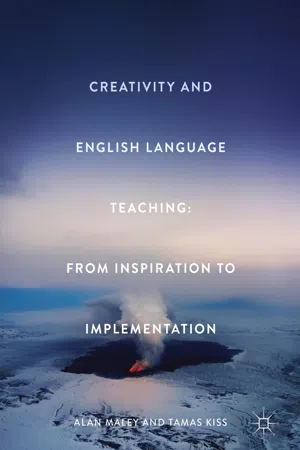Why did we decide to write this book? Because we believe passionately in the centrality of creativity in language education, in learning in general and in life itself. This is not to say that creativity is the only important factor in language learning—but without it the quality of the learning experience is seriously depleted. Creativity is not simply an optional add-on to what we do but is its very essence.
We wrote it too because creativity is so widely regarded as a desirable thing to have, in virtually every field
. From fashion to architecture, from hand-held devices to gardening, from management to education, from computer games
to interior design, everyone seems to believe that creativity is ‘a good thing’. It also comes top of Maslow’s
pyramid and Bloom’s Taxonomy. And Ken Robinson
proclaims that “creativity is the new literacy”. Unfortunately, when a term becomes a buzzword, its meaning is progressively blurred by its use in so many different contexts. Creativity shares this erosion of clarity with a whole range of other words in popular use: identity,
culture, communicative, democracy,
motivation, quality—and so on. So one of our aims in writing this book is to try to define a little more clearly just what creativity might mean.
This is particularly important when, on closer examination,
the concept proves frustratingly difficult to define concisely and accurately. Creativity is something we readily recognise in concrete instances yet find a slippery customer when asked to define it in abstract terms. As Amabile (1996, p. 33), in
one of the core texts on creativity, admits, “a clear and sufficiently detailed articulation of the creative process is not yet possible.” And she adds that “the nature of creativity is such that a complete and useful theory of creativity cannot be a single, simple theoretical statement” (p. 270). It is therefore perhaps preferable to regard creativity as a cluster of characteristics, along the lines of Wittgenstein’s (2001) notion of ‘family resemblances’. This means that here is a whole range of possible defining characteristics, but only some may be in play
in any one instance.
For those in need of a clear definition, there now seems to be a consensus around
Sternberg’s three key conditions for defining an act as creative: novelty, quality and relevance (Kaufman & Sternberg, 2010, p. xiii).
The need for creative ideas also to be relevant is clearly a key criterion. Novelty alone is not enough.
In addition to outlining at least some of the defining traits of creativity, we will also aim to identify and bring together the factors which favour creativity, particularly in the
domain of language education, not least the role of the teacher. These will underpin much of the material
in Parts 2 and 3. Necessarily, we shall also draw attention to factors which constrain or discourage the
exercise of creativity.
In Part 1, we shall review a variety of existing work in the field
of creativity. In Chap. 2 we analyse work in general creativity theory and, from there in Chap. 3, pass to the field
of education. Narrowing the field
, in Chap. 4, we then review work in applied linguistics,
then move on in Chap. 5 to language methodology
and the role creativity has played in its development. Finally, in Chap. 6, we look at some concrete applications of creativity in published language teaching materials
. In Part 1, then, there is a progressive narrowing of focus in two senses: from theoretical to practical, and from general to language-teaching specific. In this way we hope to winnow out the essential nature of creativity and the conditions which favour its development, as well as its potential benefits.
Along the way, we hope to explore the relationship between creativity and play, creativity and scientific and artistic invention and discovery, creativity and the unconscious, and creativity and learning.
Part 2 focuses on teachers. In Chap. 7, we first attempt to define what qualities characterise creative teachers, based on a number of surveys, including one we conducted ourselves. We then pass in Chap. 8 to a consideration of ways in which teachers can become more creative persons. Our argument is simply that unless teachers as individuals have themselves developed a creative mind-set, they are unlikely to be able to graft creativity on to their daily practice. Chapter 9 focuses on ways of helping teachers integrate more creative ideas into their teaching and developing their personal creativity both within and beyond training programmes. One key area for discussion is the need for teachers to develop strategies for dealing with the unpredictability which is at the heart of teaching through improvisation
and spontaneity.
In Part 3 we first discuss, in Chap. 10, the basic prerequisites for bringing about a creative classroom. In Chap. 11, we offer some frameworks
and principles for applying them to materials
design. We refer back to some of the principles derived from Part 1. The focus here will be on designing materials
which will stimulate creativity in the students, including the ways students themselves can contribute to generating their own
materials.
Finally, in Part 4, we will consider how classroom research and inquiry might contribute to the greater application of creative ideas and practices. Chapter 12 discusses some general issues in creativity research. In Chap. 13, we review some of the existing research in English language teaching on creativity. Chapter 14 provides a network
analysis of research, with some intriguing findings. Finally, in Chap. 15 we offer suggestions for some possible research projects.
References
Amabile, T. M. (1996). Creativity in context. Boulder, CO: Westview Press.
Kaufman, J. C., & Sternberg, R. J. (2010). The Cambridge handbook of creativity. New York: Cambridge University Press.
Wittgenstein, L. (2001). Philosophical investigations. Oxford: Blackwell.
